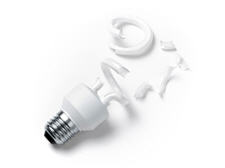Clean them up Safely
Many homeowners are trying energy efficient compact fluorescent lamps or bulbs (also called CFLs) in their homes for the first time. The Florida Department of Environmental Protection recommends trying them in many different applications and checking with the manufacturer’s labeling to choose the best bulb for your needs. A variety of color qualities, wattages and sizes are available. The Department also recommends that these bulbs be recycled at the end of their life.
Mercury Inside
Each CFL does contain a small amount of mercury, usually around 5 milligrams, an amount that would cover the tip of a ball point pen. In comparison, a mercury fever thermometer usually contains about 500 milligrams of mercury. Mercury should be kept out of the environment, and although CFLs have a very small amount of this element, a responsible user will realize that everyone’s contribution to environmental stewardship by recycling is important.
To find a place to recycle these bulbs and other household hazardous waste visit www.earth911.org or call 1-800-CLEANUP where you will be instructed to use your zip code to learn about recycling options in your area of Florida.

If One Breaks
If you should break a CFL or other fluorescent lamp in your home, the Department recommends that you use the following guidelines for clean up.
1. Ventilate the room
- Open a window
- Leave the room and restrict access for at least 30 minutes*.
- If available, point a floor or pedestal fan at the open window. Using a ceiling fan will not be as helpful at moving the air out of the window.
2. Pick up all materials you can
- Wear disposable gloves.
- Carefully scoop up the fragments and powder with stiff paper or cardboard.
- Sticky tape (such as duct tape) can be used to pick up small pieces and powder.
- Wipe the area clean with a damp paper towel or disposable wet wipe.
3.Double bag and recycle /p>
- Place the broken CFL and cleanup materials in doubled plastic bags and seal the bags
- TTake the materials to a local household hazardous waste center or collection event, a fluorescent lamp recycling facility, or put into the household trash stored outside if no other recycling options are available.
4. Wash your hands
*DEP modeling showed that a 12 ft by 12 ft room will be cleared of mercury vapors within this amount of time.
See “Remediation of Indoor Airborne Mercury Released from Broken Fluorescent Lamps,” DEP, June 2007
